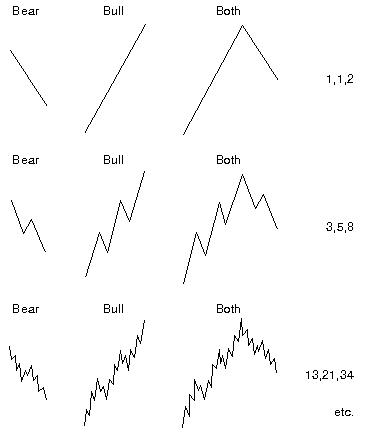Basic Tenets of the Elliott Wave Principle
Post on: 12 Май, 2015 No Comment

by Harry P. Schlanger
This article explains the basic tenets of the Elliott Wave Principle, including a few associated construction rules. These need to be followed by the Elliott technician for successful wave counting in preparation for forecasting and trading the next big market move.
Knowledge about the Wave Principle can be applied to trading any market such as the stock market, commodities markets (pork bellies, precious metals, forex, etc), or financials.
Markets Reduce to Tides of Waves
Charles Henry Dow was first to adopt the abstraction comparing market trends with tides: the waves are subordinate to the tide and the ripples in the water are subordinate to the waves.
However, Elliott’s work presented a greater precision in the classification of the various price movements of a complete market cycle, than that of Charles Dow’s trend theory.
A fascination of the Wave Principle is Elliott’s basic pattern repeating itself again and again. Waves begin with the sub-minuette cycle, on to the minor cycle, still up to the intermediate cycle, continuing on to the grand super cycle of one hundred years or more, which span major changes in our civilization.
The Five Basic Tenets of Elliott Waves
Elliott’s basic pattern is quite simple to comprehend. The Wave Principle can be summarized in five important statements:
- Financial market movements in the direction of the main trend are impulse moves. Movements counter to the main trend are corrective moves (see figure 1).
- All impulse moves have five subordinate waves, while all corrective moves have three waves.
- When the main trend is upward, waves 1, 3, and 5 are impulse moves and waves 2 and 4 are corrective moves. When the main trend is downward, the first wave, A, and third wave, C, become corrective moves, while the second intervening wave, B, becomes a corrective move.
- The action of the main trend can be taking place over a time frame from a few hours to many years. When the main trend has completed a series of five waves, it reverses and a counter move of three waves is expected.
- When completed, a move comprising of five waves followed by a counter wave, is the first cycle movement. This will represent the first (1) and second (2) waves of a cycle in the time frame of the next higher degree.
Important Associated Rules
A few associated rules should be known before the Wave Principle can be properly utilized for trading in the markets.
- Wave 3 cannot be the shortest of the impulsive waves
- Waves 1 and 4 should not overlap
- Wave 2 and 4 should alternate. That is, if one wave is a correction of complex shape, then the other wave will probably be of a simple pattern.
Elliott Waves often relate with Fibonacci ratios. Corrective waves often retrace either 38.2% or 61.8% of the impulsive waves. In addition, waves 2 and 4 often relate according to these two ratios.
Application of the Wave Principle in Markets
This article presents the rudiments of the Wave Principle, but learning to count waves is only the first step. It is suggested that the potential Elliott Wave practitioner obtain a good book to study further details of the subject, such as the array of triangles and the plethora of corrective patterns; and how to use the Wave Principle for trading — timing entries and exits.
Elliott Wave software is a useful tool for facilitating the complex counting task. The software also provides swing ratios. Familiar ratios at completed swings can indicate increased probabilities for the market to turn.
References:
- “Powertiming – Using the Elliott Wave Principle to Anticipate and Time Market Turns”. Robert C. Beckman. Probus Publishing Co. Chicago, 1992.
- Elliott Wave Simplified — Making Stock Market profits with RN Elliott’s Simple Theory, Clif Droke. MarketPlace Books, 2000.














